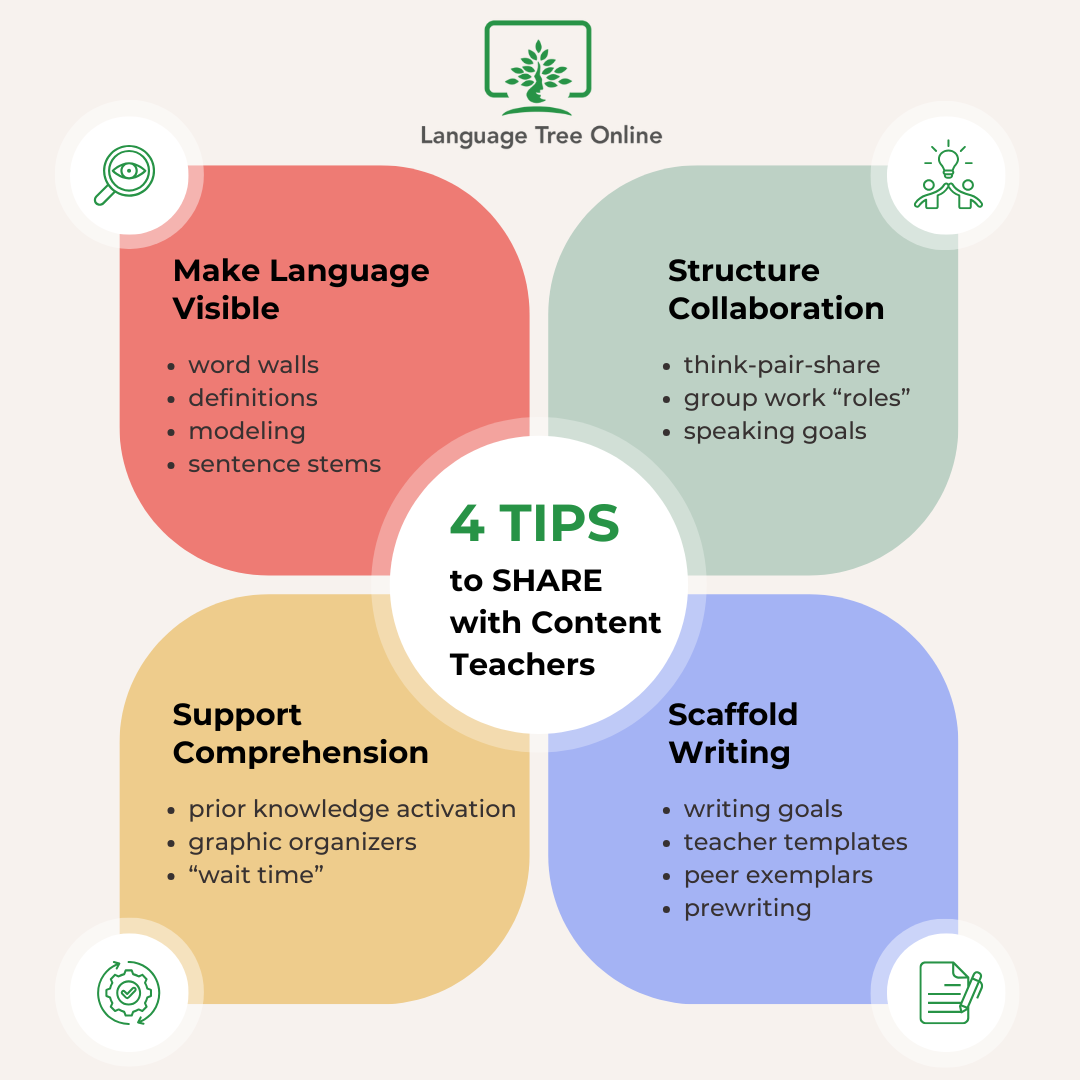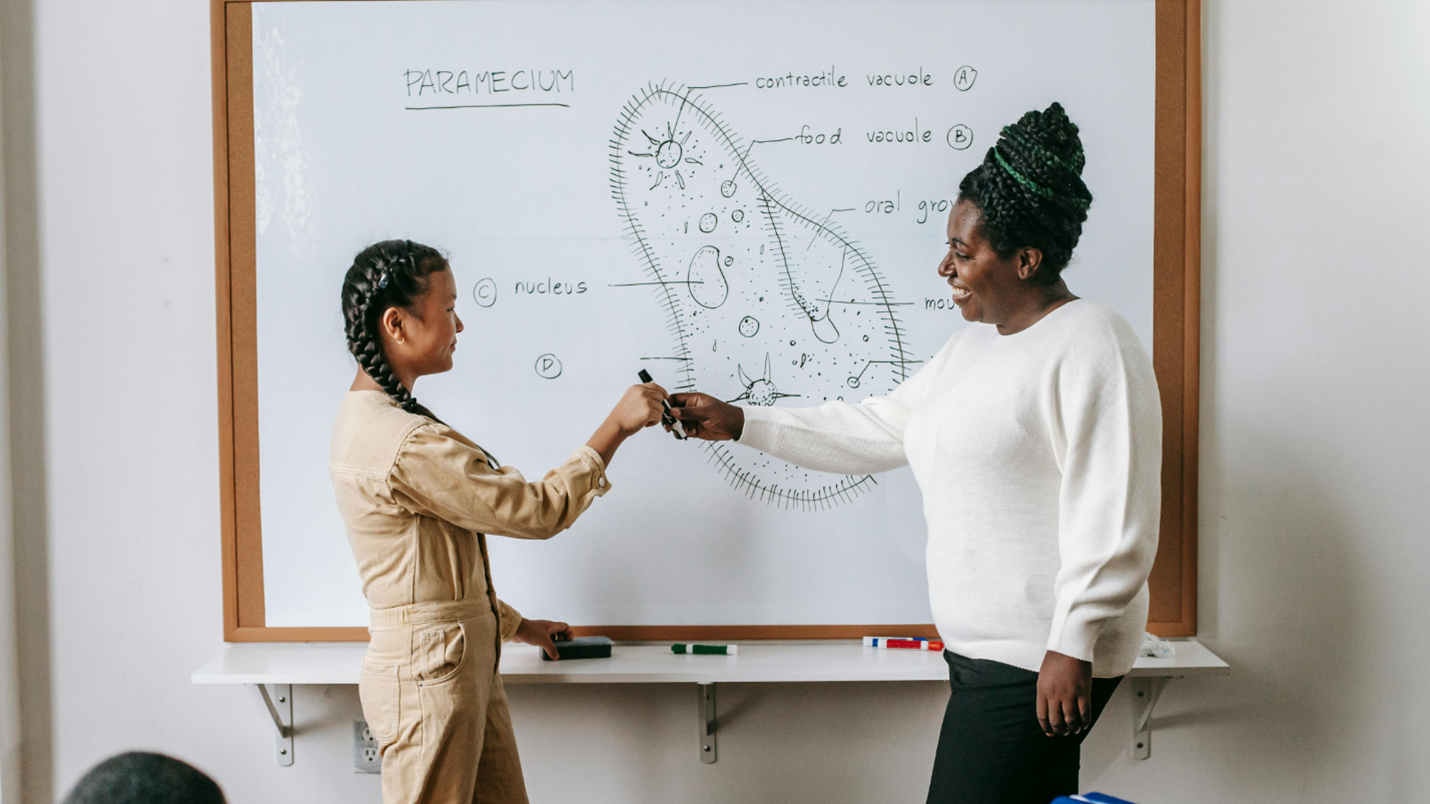How to Coach Content Teachers: A Practical Guide for ELD Specialists
"How can I help my content teachers with strategies to support our English learner students?"
This question surfaces regularly in ELD teacher communities, and for good reason. You recognize that your English learners need more than what they're currently receiving in content area classrooms, but approaching colleagues about their instructional practices requires finesse and clear direction.
The reality is that ELD and content teachers same goals: to support English learners effectively. However, content area teachers may lack training in English learner instructional strategies to make it happen. Your role as an ELD specialist positions you perfectly to help bridge this gap through targeted coaching focusing on practical, research-based approaches that can be implemented easily.
Before diving into specific content area strategies, it's important to understand what effective ELL instruction requires. Research shows that English learners need explicit language instruction embedded in content learning, not just accommodations. (Himmel, n.d.) That’s because of common challenges such as the abundance of figurative language in English texts, unfamiliar academic vocabulary across content areas, and trying to keep up with what the teacher is saying during class.
The infographic below presents general strategies you can share with content teachers in grades 6-12. Read on to learn about specific strategies and tactics organized by different content areas.

Mathematics: Building Language Around Mathematical Concepts
Mathematics presents specific challenges for English learners. Students may use different processes to arrive at answers due to cultural differences in mathematical instruction. Additionally, mathematical terms do not always translate well, and the concept of word problems may not have been introduced to students from other countries.

Methods for Math Teachers to Support English Learners
- Show students how language ‘lives’ in mathematical discourse: Help them by introducing sentence frames specific to mathematical reasoning: "The pattern shows...", "I can prove this by...", "This is similar to... because...". Post these frames prominently and model their use during problem-solving demonstrations.
- Aid comprehension with visual representations: It’s important to consider that some students may have never seen math manipulatives, such as review cards and algebra tiles. Therefore, they may be unfamiliar with the ways manipulatives can be used for learning. Coach teachers to explicitly connect manipulatives to abstract concepts and provide written explanations alongside hands-on activities.
- Structure problem-solving in a paired framework: Implement think-pair-share for solving complex word problems. This type of collaborative activity gives students time to understand the task, reflect, and translate new academic vocabulary ("think") before collaborating with a peer to evaluate ("pair"). Also, students can test out sentence structure with their partner before sharing with a larger group ("share"). The opportunity to discuss and rehearse with a peer helps build confidence in speaking.
- Scaffold written responses by guiding students through deconstructing the problem: Before expecting full explanations, have students use templates as a guide: "The problem is asking for___", "I know that___", "My strategy is___", and "The answer is___ because___".
Science: Connecting Language to Inquiry
Scientific vocabulary and processes can create a significant academic hurdle for English learners. Even simple words that the student may already know could have another meaning in science. Directions for an experiment and descriptions of scientific processes are often multistep and complex.

How to Support ELLs in Science Classes
- Use the “think-aloud” strategy to model the language of scientific thinking: Model examples and create visual thinking stem resources around the room to support the scientific method. Examples include: "I predict that... because...", "My observations show...", "The data supports...", and "I can conclude...". Display these during labs and require their use in scientific discussions and writing.
- Boost comprehension through explicit background building: English learners may lack background knowledge in science, so finding and drawing conclusions on their own may prove difficult. To address this challenge, teachers should explicitly build background knowledge before introducing new scientific concepts. This can include pre-teaching key vocabulary with visual supports, connecting new concepts to students' cultural experiences and prior knowledge from their home countries, and providing concrete experiences through hands-on activities, demonstrations, or multimedia resources.
- Organize collaboration for projects and investigations: Assign specific roles during lab work that allow English learners to participate meaningfully regardless of their current language proficiency level. Consider roles such as "materials manager" (gathering and organizing equipment), "timekeeper" (monitoring experiment duration and transitions), "safety monitor" (ensuring proper procedures are followed), "data collector" (recording numerical measurements or making observations through drawings/diagrams), or "equipment specialist" (operating tools and technology). These roles emphasize hands-on participation, visual skills, and non-verbal contributions rather than requiring advanced reading, writing, or oral presentation skills.
- Scaffold writing expectations: Begin with sentence frames for observations, such as "When I added___, I noticed___". Then, progress to paragraph templates: "The purpose of this experiment was___. My hypothesis was___. The results showed___."
US History: Bridging Cultural and Historical Understanding
Students from different countries likely have very limited background knowledge of U.S. history. Also, many government-related concepts simply don't exist in all cultures, such as a bicameral system of legislature or the Electoral College.
Strategies to Support English Learners in History Class
- Make language visible through historical analysis: Develop sentence frames for analyzing primary sources: "This document suggests...", "The author's perspective is...", or "This connects to... because...". Create a “word wall” complete with academic vocabulary that pairs historical terms being studied with visual representations and student-friendly contextual explanations.
- Support retention and comprehension through cultural connections: Begin new units by discussing the global timeline of events happening in the same era across the world. If your English learners are from a different country, be sure to highlight the important key events relative to those locations. Coach teachers to explicitly connect historical events to students' background knowledge and invite comparisons to their home countries' experiences.
- Collaborate using different perspectives in small group instruction: Use structured discussions where students examine historical events from different viewpoints. Provide role cards with specific language: "As a farmer in 1930, I would have felt..." "From the government's perspective..." or "Citizens probably thought..."
- Support explaining and expanding on ideas through historical argumentation: Start with evidence-based sentence completion: "The primary cause was___ because the document shows___". Build toward paragraph frames that require students to make claims, provide evidence, and explain connections.
English Language Arts: Accessing Literary Texts
English literature creates unique challenges for ELLs because it is heavily culture-bound. To comprehend modern and classical literature, students often need prior knowledge of cultural references and stories found in fairy tales, myths, and legends familiar to Americans. Also, because of the heavy use of figurative language and cultural nuances in literature, students may be able to read the words, but it doesn't mean they will understand the intricacies of what the author was trying to convey in the text.
Scaffolding Strategies for ELs in ELA
- Make the language of literary analysis explicit: Create sentence frames for analyzing all aspects of the plot. For example, use stems to support character analysis: "The character's actions reveal...", "This quote shows...", "The author's message was...". Additionally, provide graphic organizers that help students track character development, plot progression, and thematic elements.
- Facilitate comprehension through cultural context: ELLs may not fully understand information that is implicit or that the author has left "unsaid". Pay attention to whether the text has embedded American cultural cues, such as traditions or superstitions. Coach ELA teachers to provide English learners with background knowledge fact sheets that help clarify cultural references, historical context, and implied information in the text they are analyzing.
- Implement "literature circles" in small groups: Structure collaboration through discussion circles about a reading passage with roles that accommodate varying language proficiency levels. Consider assigning roles such as "visual organizer" (creating drawings, diagrams, or graphic organizers to represent key ideas), "connection illustrator" (finding or drawing images that relate the text to real life or other experiences), "question generator" (developing questions using provided stems or working with a partner), "evidence collector" (highlighting or marking important text passages), or "summary sketcher" (creating visual summaries or timelines of events).
- Practice writing responses to open-ended questions about the text: Provide students with a template response framework to guide their written answers. Students should understand that they must not only answer the question asked, but also provide specific examples from the text that provide evidence to support their interpretation. Guide them with quote sandwiches: "The text states ___.", "This shows___.", "This is important because___." Progress to longer analysis paragraphs using frames that require multiple evidence examples and more detailed explanations.
How Do You Know if the Content Teacher is Successful?
 Success in coaching content teachers isn't just about strategy implementation but about measurable improvements in English learner outcomes. Look for these indicators:
Success in coaching content teachers isn't just about strategy implementation but about measurable improvements in English learner outcomes. Look for these indicators:
- Increased academic language use: Students begin incorporating subject-specific vocabulary and sentence structures in their spoken and written responses, moving beyond simple yes/no answers to more complex explanations.
- Enhanced content comprehension: English learners demonstrate deeper understanding of concepts through improved performance on assessments, more sophisticated questions, and stronger connections between ideas.
- Greater classroom participation: Students volunteer more frequently, engage in peer discussions with confidence, and take on leadership roles in group activities.
- Improved quality of student work: Written assignments show more complex sentence structures, appropriate use of academic vocabulary, and clearer organization of ideas.
In Conclusion: Building Your Coaching Practice
Remember that we said “finesse” is required to get content teachers to change their approach? Effective coaching also relies on relationship building. Begin by identifying one content teacher who has already expressed interest in supporting English learners more effectively. Focus on introducing one strategy at a time, providing materials and templates that make implementation straightforward.
Document student progress using specific examples of improved work quality, increased participation, or enhanced understanding. Share these successes with other teachers to build momentum for broader implementation across content areas.
Remember that sustainable change happens gradually. Focus on strategies that address the most significant barriers your English learners face while remaining realistic about teacher capacity and time constraints. Your expertise as an ELD specialist provides exactly what content teachers need to make their instruction more accessible for English learners. By focusing on practical implementation and measurable results, you create lasting change that benefits not only English learners but all students in content area classrooms.
Sources Cited
Himmel, J. (n.d.). Language objectives: The key to effective content area instruction for English learners. Colorín Colorado. https://www.colorincolorado.org/article/language-objectives-key-effective-content-area-instruction-english-learners
 About the Author
About the Author
With a passion for education, Mary supports Language Tree Online's customer success and marketing initiatives. Mary is a certified teacher and administrator in the states of New Jersey and Delaware with a Master’s in Educational Leadership and School Business Administration. She spent the better part of a decade teaching Literacy, History, and Health to middle school English language learners in an inclusion classroom.